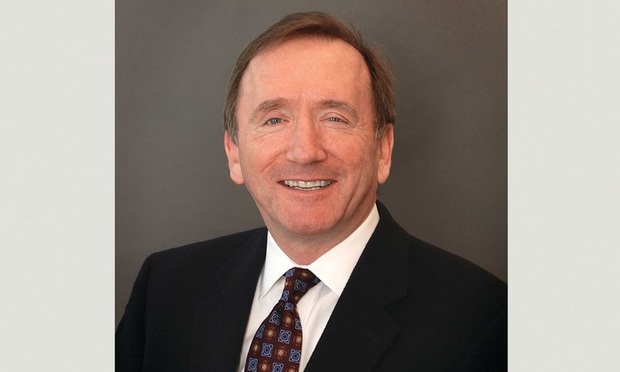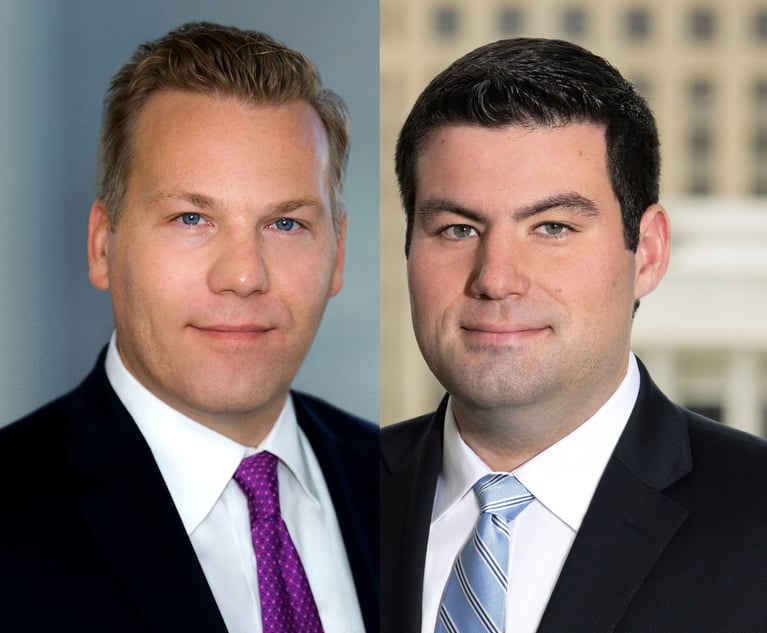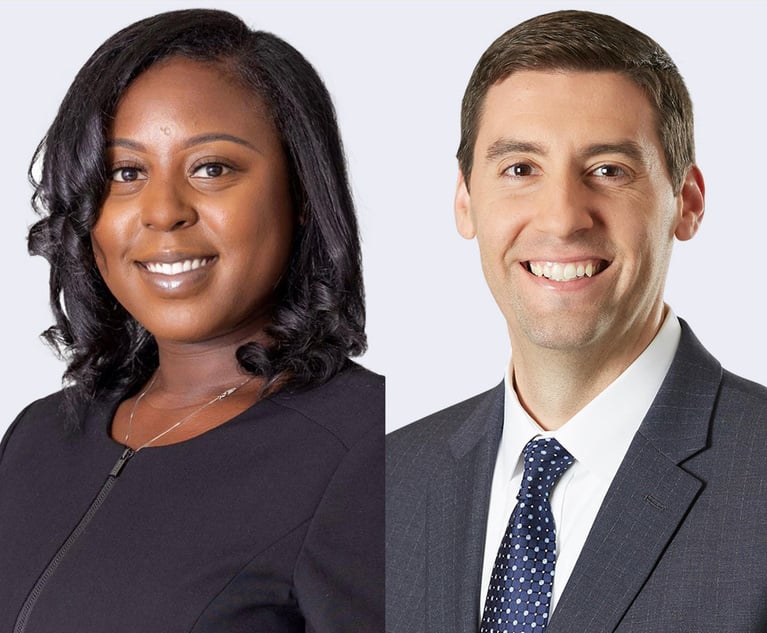Partnership Loses Its Principal Asset, a Qui Tam Action, Upon Substituting a New Partner for an Old One
In JKJ Partnership 2011 v. Sanofi-Aventis US, the Delaware Supreme Court, answering certified questions from the U.S. Court of Appeals for the Third Circuit, held that when a partnership replaced one of its original three partners with a new partner, the partnership dissolved.
April 01, 2020 at 09:07 AM
5 minute read
 Michael R. Lastowski of Duane Morris (Courtesy Photo)
Michael R. Lastowski of Duane Morris (Courtesy Photo)
In JKJ Partnership 2011 v. Sanofi-Aventis US, No. 256, 2019, slip op. (Del. Mar. 17, 2020), the Delaware Supreme Court, answering certified questions from the U.S. Court of Appeals for the Third Circuit, held that when a partnership replaced one of its original three partners with a new partner, the partnership dissolved. As a result, the partnership may have lost the ability to fulfill its essential purpose—the pursuit of a qui tam action.
Three individuals (A, B and C) were whistleblowers who alleged that several drug companies had marketed a product without sufficiently warning the public of potentially harmful effects. To protect their anonymity, the individuals formed a partnership (original partnership). The original partnership filed a qui tam action against several drug companies. Post-filing, Partner A left the partnership. Partner G joined the partnership. The "partnership" filed an amended complaint in the qui tam action.
Only the person/entity that is the "first to file" has standing to pursue a qui tam action. The first-to-file bar provides that, once a qui tam action has been brought on a claim, "'no person other than the government may intervene or bring a related action based on the facts underlying the pending action,'" In re Plavix Marketing, Sales Practices and Products Liability Litigation (No. II), 315 F. Supp. 3d 817, 829-30 (D.N.J. 2018) (quoting Heath v. AT&T, 791 F.3d 112, 120 (D.C. Cir. 2015) (citing 31 U.S.C. Section 3730(b(5))). In response to the amended complaint, the defendants moved to dismiss. The defendants successfully argued that, upon the substitution of partners, a new partnership (new partnership) was formed and that the new partnership was an untimely intervenor that lacked standing. The new partnership appealed to the Third Circuit, which then certified several questions to the Delaware Supreme Court: When original Partner A left and a new partner joined, did the original partnership continue to exist? If a new partnership was created, did the original partnership terminate immediately such that the new partnership necessarily filed the amended complaint or did the original partnership file the amended complaint as part of its "winding up" process? If the original partnership did not survive the substitution of partners, may its individual partners continue to pursue the qui tam action as part of the "winding up" process?
With regard to the first question, the Delaware Supreme Court held that the substitution of partners caused the dissolution of the original partnership and the creation of the new partnership. The court explained that there are two theories of partnership: the "aggregate" model and (b) the "entity" model. Under the aggregate theory, a partnership is not a distinct legal entity—it is merely an aggregation of individuals. The partnership cannot sue or be sued in the partnership name. Under the entity theory, a partnership is a legal entity distinct from its individual partners and can sue and be sued.
Delaware has adopted the Delaware Revised Uniform Partnership Act, 6 Del. C. Section 15-101, which adopts the entity theory of partnerships. However, "it is the policy of [DRUPA] to give maximum effect to the principle of freedom of contract and to the enforceability of partnership agreements." 6 Del. C. Section 15-103(d). The partnership agreement provided that the original partnership was not a legal entity distinct from its partners. As the Supreme Court noted, this provision means that "[the original partnership] consists of an association of Partners A, B and C." Further, the "new aggregation of partners A, C and G resulted in the [creation of the new partnership] and a dissolution of the [original partnership]."
With regard to the second question (did the new partnership file the amended complaint during the wind down process?), the Supreme Court held that the record was insufficient to support a finding as to whether the "winding up" process was complete when the amended complaint was filed. The court noted that the more critical question was whether the qui tam action was transferred from the original partnership to the new partnership. Again, however, the record was insufficient to support any finding. However, it was clear that the new partnership filed the amended complaint—among other things the amended complaint identified the partners as A, B and G.
Finally, in answering the third question, the court held that even if the original partnership was still engaged in the "winding up" process, the original partnership cannot pursue the qui tam action. Pursuing the qui tam action was the "singular purpose" for which the original partnership was formed. Continuing the main business of the original partnership is "not consistent with 'winding up.'"
This case is a stark illustration of the law of unintended consequences. The mere substitution of partners resulted not only in the dissolution of the original partnership, but also the potential conclusive defeat of the purpose for which the partnership was created—pursuit of a qui tam action. A careful reading of the partnership agreement and the DRUPA could have avoided this result.
Michael R. Lastowski is the managing partner of Duane Morris' Wilmington office. He practices in the areas of bankruptcy law and commercial litigation.
This content has been archived. It is available through our partners, LexisNexis® and Bloomberg Law.
To view this content, please continue to their sites.
Not a Lexis Subscriber?
Subscribe Now
Not a Bloomberg Law Subscriber?
Subscribe Now
NOT FOR REPRINT
© 2025 ALM Global, LLC, All Rights Reserved. Request academic re-use from www.copyright.com. All other uses, submit a request to [email protected]. For more information visit Asset & Logo Licensing.
You Might Like
View All
Chancery: Common Stock Worthless in 'Jacobson v. Akademos' and Transaction Was Entirely Fair
5 minute read
The Importance of Contractual Language in Analyzing Post-Closing Earnout Disputes
6 minute read
Delaware Supreme Court Upholds Court of Chancery’s Refusal to Blue Pencil an Unreasonable Covenant Not to Compete
4 minute readLaw Firms Mentioned
Trending Stories
- 1Mastering Litigation in New York’s Commercial Division Part V, Leave It to the Experts: Expert Discovery in the New York Commercial Division
- 2GOP-Led SEC Tightens Control Over Enforcement Investigations, Lawyers Say
- 3Transgender Care Fight Targets More Adults as Georgia, Other States Weigh Laws
- 4Roundup Special Master's Report Recommends Lead Counsel Get $0 in Common Benefit Fees
- 5Georgia Justices Urged to Revive Malpractice Suit Against Retired Barnes & Thornburg Atty
Who Got The Work
J. Brugh Lower of Gibbons has entered an appearance for industrial equipment supplier Devco Corporation in a pending trademark infringement lawsuit. The suit, accusing the defendant of selling knock-off Graco products, was filed Dec. 18 in New Jersey District Court by Rivkin Radler on behalf of Graco Inc. and Graco Minnesota. The case, assigned to U.S. District Judge Zahid N. Quraishi, is 3:24-cv-11294, Graco Inc. et al v. Devco Corporation.
Who Got The Work
Rebecca Maller-Stein and Kent A. Yalowitz of Arnold & Porter Kaye Scholer have entered their appearances for Hanaco Venture Capital and its executives, Lior Prosor and David Frankel, in a pending securities lawsuit. The action, filed on Dec. 24 in New York Southern District Court by Zell, Aron & Co. on behalf of Goldeneye Advisors, accuses the defendants of negligently and fraudulently managing the plaintiff's $1 million investment. The case, assigned to U.S. District Judge Vernon S. Broderick, is 1:24-cv-09918, Goldeneye Advisors, LLC v. Hanaco Venture Capital, Ltd. et al.
Who Got The Work
Attorneys from A&O Shearman has stepped in as defense counsel for Toronto-Dominion Bank and other defendants in a pending securities class action. The suit, filed Dec. 11 in New York Southern District Court by Bleichmar Fonti & Auld, accuses the defendants of concealing the bank's 'pervasive' deficiencies in regards to its compliance with the Bank Secrecy Act and the quality of its anti-money laundering controls. The case, assigned to U.S. District Judge Arun Subramanian, is 1:24-cv-09445, Gonzalez v. The Toronto-Dominion Bank et al.
Who Got The Work
Crown Castle International, a Pennsylvania company providing shared communications infrastructure, has turned to Luke D. Wolf of Gordon Rees Scully Mansukhani to fend off a pending breach-of-contract lawsuit. The court action, filed Nov. 25 in Michigan Eastern District Court by Hooper Hathaway PC on behalf of The Town Residences LLC, accuses Crown Castle of failing to transfer approximately $30,000 in utility payments from T-Mobile in breach of a roof-top lease and assignment agreement. The case, assigned to U.S. District Judge Susan K. Declercq, is 2:24-cv-13131, The Town Residences LLC v. T-Mobile US, Inc. et al.
Who Got The Work
Wilfred P. Coronato and Daniel M. Schwartz of McCarter & English have stepped in as defense counsel to Electrolux Home Products Inc. in a pending product liability lawsuit. The court action, filed Nov. 26 in New York Eastern District Court by Poulos Lopiccolo PC and Nagel Rice LLP on behalf of David Stern, alleges that the defendant's refrigerators’ drawers and shelving repeatedly break and fall apart within months after purchase. The case, assigned to U.S. District Judge Joan M. Azrack, is 2:24-cv-08204, Stern v. Electrolux Home Products, Inc.
Featured Firms
Law Offices of Gary Martin Hays & Associates, P.C.
(470) 294-1674
Law Offices of Mark E. Salomone
(857) 444-6468
Smith & Hassler
(713) 739-1250







